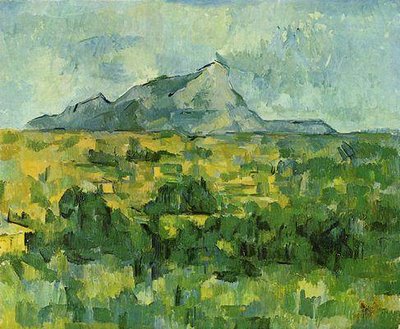
This blog's title is based upon the best question I ever overheard being asked, by a young Liverpudlian child to his mother, as in "What's..?". The answer seems to be something of a creative and cultural nature which, in deed (primarily the making of art) and word, this blog intends to explore...
Sunday, October 22, 2006
Cezanne
Today marks the centenary, to the very day, of the passing of Paul Cezanne, the father of modern painting & a great personal hero. I wasn't aware of the actual date (only the year) of his death until late last night, whilst watching the Phaidon video of Cezanne's life & work, loaned from the college library that has recently come to be the site of the latest day job. Towards the end of the film, a shot scans across the surface of his tombstone, revealing the death date as being 22 Octobre 1906, a scene I was watching shortly after the clock had ticked over past midnight into today: a most strange coincidence but fitting indeed. Here's an iconic image to mark the event.


Sunday, October 08, 2006
'Current' artwork
Recently took the opportunity to photograph one of my old-yet-still-most-recent pieces of art work in situ at a friend’s home. This work is now 5 – 6 years old, initiated within an academic environment, but still represents my most recent serious creative practice &, I believe, having recently(ish) read James Meyer’s ‘Minimalism: Art & Polemics in the 60s’ & refreshed my memory with some of the concerns & ideas that informed this small body of work-in-progress, might still provide scope for further exploration should circumstances ever allow.
Although still images are inadequate to properly describe the true nature of this piece, a selection of photos of it & some related work follow, & then some form of explanation into the ideas & intentions behind its making is included, being essentially a statement – which still probably provides the most cogent & appropriate exposition - accompanying the work as it appeared on my old personal website, now becalmed.
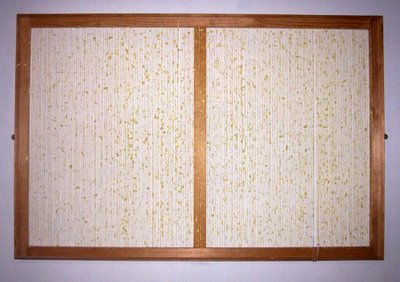





Next is another 'stringed' piece, this time with no paint applied to the threads, merely to the stretcher (this results in a particularly 'gossamery' surface effect when viewed actively), followed by a related work, this time utilising a grid of threads, the oil paint slathered thickly over the whole surface then allowed to fall through, some, obviously onto the stretcher.


This is the original statement - by no means new itself but still seeming relevant - accompanying the work.
“The following small body of work, to be regarded as proposals, sketches, for work yet to be made, comprises examples of the ideas informing the direction in which I intend my progressive practice to develop.
The objects are created with the intention of being 'moving pictures', combining drawing and painting in a three-dimensional form that emphasizes the physicality and facture of the work and demands an embodied, active participation of the spectator in the realisation of the 'work of art' and recognition of a shared physical presence in the world.
In formal terms, the objects draw on a modernist and minimalist vocabulary of simple line and grid structures which act as both drawing and the physical framework to which paint is applied (or not). The open nature of these structures allows the works to function three-dimensionally and explore possibilities beyond the surface, incorporating the wall upon which the objects are hung as an essential component of the work, as the 'screen' upon which shadows are projected and form part of the drawn/painted image.
As a full appreciation of this effect depends upon the spectator moving across the picture plane, causing an optical 'ripple' to pass over it in the case of the vertically strung works, or moving in more closely to observe the fall of the paint through the grid onto the stretcher behind in the other, gridded, instance, the physical space occupied by the object also extends in front of it into that of the spectator, setting up a dialogue between the former and the embodied consciousness of the latter, as would occur during the course of viewing a sculpture or other 3D object 'in the round'.
In each instance, process is essential to the creation of the work and recognition and understanding of the 'work of the work' which, in its reception, becomes an ongoing, unresolved aspect of each piece.
First, a stretcher was constructed and then a piece of canvas, as would usually be stretched over such a structure, was unpicked thread by thread before being stretched in the same manner, and 'rewoven' in the case of the grid piece. Thick, only slightly thinned oil paint was applied to either the canvas threads or the stretcher; spread evenly across the grid, upon which it either sat or fell through, or brushed, drawn, horizontally along the length of one of the vertically-strung pieces, where it would form random clumps, or similarly fall to sometimes link neighbouring threads.
These processes lead to works that combine, initially, strict order and then pure chance; two- and three-dimensionality as essential qualities of their nature; question the integrity of the picture plane whilst remaining pictorial in nature, and feature drawing and painting as both separate and conjoined aspects of their making and being.
It is intended that the vertically strung pieces will develop on a much wider, 'panoramic' scale, which seems a necessary condition of the full realization of the optical nature of their surface effects as 'moving pictures' enabling recognition of the viewer's embodied and temporal existence in physical space”.
Interesting to note that, given the recent photos taken & posted of that damaged wire fence, as ‘drawing in space’ (see previous post), my concerns do seem to have endured, despite a significant period of not-making artwork, certainly of this nature.
Although still images are inadequate to properly describe the true nature of this piece, a selection of photos of it & some related work follow, & then some form of explanation into the ideas & intentions behind its making is included, being essentially a statement – which still probably provides the most cogent & appropriate exposition - accompanying the work as it appeared on my old personal website, now becalmed.






Next is another 'stringed' piece, this time with no paint applied to the threads, merely to the stretcher (this results in a particularly 'gossamery' surface effect when viewed actively), followed by a related work, this time utilising a grid of threads, the oil paint slathered thickly over the whole surface then allowed to fall through, some, obviously onto the stretcher.


This is the original statement - by no means new itself but still seeming relevant - accompanying the work.
“The following small body of work, to be regarded as proposals, sketches, for work yet to be made, comprises examples of the ideas informing the direction in which I intend my progressive practice to develop.
The objects are created with the intention of being 'moving pictures', combining drawing and painting in a three-dimensional form that emphasizes the physicality and facture of the work and demands an embodied, active participation of the spectator in the realisation of the 'work of art' and recognition of a shared physical presence in the world.
In formal terms, the objects draw on a modernist and minimalist vocabulary of simple line and grid structures which act as both drawing and the physical framework to which paint is applied (or not). The open nature of these structures allows the works to function three-dimensionally and explore possibilities beyond the surface, incorporating the wall upon which the objects are hung as an essential component of the work, as the 'screen' upon which shadows are projected and form part of the drawn/painted image.
As a full appreciation of this effect depends upon the spectator moving across the picture plane, causing an optical 'ripple' to pass over it in the case of the vertically strung works, or moving in more closely to observe the fall of the paint through the grid onto the stretcher behind in the other, gridded, instance, the physical space occupied by the object also extends in front of it into that of the spectator, setting up a dialogue between the former and the embodied consciousness of the latter, as would occur during the course of viewing a sculpture or other 3D object 'in the round'.
In each instance, process is essential to the creation of the work and recognition and understanding of the 'work of the work' which, in its reception, becomes an ongoing, unresolved aspect of each piece.
First, a stretcher was constructed and then a piece of canvas, as would usually be stretched over such a structure, was unpicked thread by thread before being stretched in the same manner, and 'rewoven' in the case of the grid piece. Thick, only slightly thinned oil paint was applied to either the canvas threads or the stretcher; spread evenly across the grid, upon which it either sat or fell through, or brushed, drawn, horizontally along the length of one of the vertically-strung pieces, where it would form random clumps, or similarly fall to sometimes link neighbouring threads.
These processes lead to works that combine, initially, strict order and then pure chance; two- and three-dimensionality as essential qualities of their nature; question the integrity of the picture plane whilst remaining pictorial in nature, and feature drawing and painting as both separate and conjoined aspects of their making and being.
It is intended that the vertically strung pieces will develop on a much wider, 'panoramic' scale, which seems a necessary condition of the full realization of the optical nature of their surface effects as 'moving pictures' enabling recognition of the viewer's embodied and temporal existence in physical space”.
Interesting to note that, given the recent photos taken & posted of that damaged wire fence, as ‘drawing in space’ (see previous post), my concerns do seem to have endured, despite a significant period of not-making artwork, certainly of this nature.
Friday, September 15, 2006
Drawing in Space, ‘Art’ in the Landscape
A recent walk in the nearby countryside led to the discovery of, an encounter with, what might be termed an unintentional sculpture, or perhaps, given the thing’s linear nature, a drawing in three-dimensional space. ‘The thing’ is in fact a broken down section of wire fence, barely noticeable against the grass upon which it lies when walking close to it, past it, yet striking when approached from below, walking uphill towards it, viewed against the sky, as I hope the following photographs may illustrate.
Viewed from a variety of angles, ‘in the round’ as any 3D object should properly be appreciated to achieve a full sense of its form, the fence/drawing displays a pleasing combination of, & play between, horizontal & vertical elements, a free-flowing, open tracery of sensual, curving, delicate-yet-purposeful lines & more massive, scribbly agglomerations or ‘passages’, which gives it too a sense of energy & something of a dynamic quality suggestive of movement, of flow. The lines, of course, exist in three dimensions, creating interesting forms such as – dependent upon viewpoint - helix-like combinations of curves, loops & more severe, jagged peaks & aggressively twisted folds, these latter similar, indeed, to aspects of the landscape such as rock formations. Whatever, these accidental transformations wrought have something of a ‘rightness’ to them & bring this to the whole & an appreciation of it, as art (designated). Also present may be observed a certain 'measured', point-to-point or join-the-dots effect appropriate to drawing, courtesy of another of the fence’s physical features, the loops that serve to keep separate the individual squares of the design.
The whole, I think, has a certain elegance and aesthetic quality that transcends its damaged state & consequent removal from a functional context, & provides an interesting addition to the landscape of which it is an organically-evolving, interactive part (note the tufts of sheep’s wool adhering in places to the fence).
The images are presented in a sequence that intends to convey something of the experience of encountering the ‘drawing’ in the landscape, seen & composed in relation to other aspects of its surroundings such as telegraph poles & wires, trees, the long grass in which it resides & which constitute another element of pictorial ‘mark-making’, etc.












Viewed from a variety of angles, ‘in the round’ as any 3D object should properly be appreciated to achieve a full sense of its form, the fence/drawing displays a pleasing combination of, & play between, horizontal & vertical elements, a free-flowing, open tracery of sensual, curving, delicate-yet-purposeful lines & more massive, scribbly agglomerations or ‘passages’, which gives it too a sense of energy & something of a dynamic quality suggestive of movement, of flow. The lines, of course, exist in three dimensions, creating interesting forms such as – dependent upon viewpoint - helix-like combinations of curves, loops & more severe, jagged peaks & aggressively twisted folds, these latter similar, indeed, to aspects of the landscape such as rock formations. Whatever, these accidental transformations wrought have something of a ‘rightness’ to them & bring this to the whole & an appreciation of it, as art (designated). Also present may be observed a certain 'measured', point-to-point or join-the-dots effect appropriate to drawing, courtesy of another of the fence’s physical features, the loops that serve to keep separate the individual squares of the design.
The whole, I think, has a certain elegance and aesthetic quality that transcends its damaged state & consequent removal from a functional context, & provides an interesting addition to the landscape of which it is an organically-evolving, interactive part (note the tufts of sheep’s wool adhering in places to the fence).
The images are presented in a sequence that intends to convey something of the experience of encountering the ‘drawing’ in the landscape, seen & composed in relation to other aspects of its surroundings such as telegraph poles & wires, trees, the long grass in which it resides & which constitute another element of pictorial ‘mark-making’, etc.












Wednesday, September 06, 2006
King Ink’s Silver Jubilee
On a whim, browsing through the CDs for some sounds to provide entertainment & perhaps inspiration, I decided to give my self-compiled Birthday Party collection (its contents in fact very similar to the officially-released ‘Hits’ CD) a listen for the first time in a while. Recalling experiencing the band in concert some 25 years ago, at the Royal Court in Liverpool (bottom of a bill that also featured Vic Godard & the Subway Sect during Vic’s lounge-crooner phase and headliners Bauhaus with, even more bizarrely, a selection of reggae records played between the bands), it struck me forcibly how fresh & vital the ’Party’s music and, for example, a classic song such as ‘King Ink’ in particular, was then and still sounds now, across that passage of time: such a silver jubilee seems worthy of recognition and celebration, I believe. In fact, other than a couple of gigs at a local FE college, featuring a selection of local bands, that gig was the 1st proper one I attended and thus the ’Party could claim to be the 1st proper band (as in one on a bona fide record label – 4AD – and heard on Peel, the ultimate stamp of authority as it were) I was fortunate enough to see live: wow - what an intro to the experience. I recall the sheer spectacle of Nick Cave's performance, a retching, bent-double stick insect, Rowland Howard a deathly-white, chain-smoking caryatid, Tracey Pew's stetson, Mick Harvey's keyboards tottering atop a stack of plastic milk crates - what a great, great band. The violence of some of this music is still shocking, and liberating. The Friend Catcher, Zoo Music Girl, A Dead Song, Nick the Stripper, Figure of Fun, Release the Bats, She’s Hit, Big-Jesus-Trash-Can, Kiss Me Black, 6" Gold Blade, Junkyard: all that howling and screeching and squawking and flailing and flaying and (death-)rattling and pounding and clattering and battering, antic, frantic and breathless, those songs teetering on the edge of tumbling down the stairs, arse over tit, to be consumed in the dark, bat-infested voids they melodramatically describe with such unwholesome relish &/or disgust, and left broken, twitching, smouldering, bloody. It might, in fact, be more appropriate to term The Birthday Party’s dank, swampy, scratchy music collectively as ‘abattoir blues’ rather than Nick Cave’s recent album of that very name. Interesting too, to compare it with Cave’s later crooning balladry, most fully realised on ‘The Boatman’s Call’ album and other, numerous examples scattered across his oeuvre, especially perhaps something as lush as the gorgeous, swooning, string-drenched ‘Love Letter’, which is quite a sonic journey to have travelled, along which may be experienced many peaks.
More Australian music, or music by Australians.
I posted in the New Year, more than once, enthusiastically and with great anticipation, on the subject of the wonderful sounds of Sol Seppy, and eventually took delivery of her album some time ago now. And most engaging it’s proved to be, too, a worthwhile addition to the music collection. I’ve found it to be, overall, a quieter listen than expected – the tantalizingly-offered likes of ‘Slo Fuzz’ and ‘Move’, sonically recalling My Bloody Valentine, being exceptions rather than the album as a whole’s rule, which is much more acoustic and reflective, where piano and cello predominate the instrumental soundscape - a lovely, intimate experience, best enjoyed through headphones to appreciate the drifting subtleties of the music and the spaces it creates. As previously noted, all sorts of references and influences can be discerned – there’s a delightful Cocteau Twins moment during ‘A to N’, just as it takes off, for instance, in addition to Sparklehorsey-type wheezings and such, My Bloody Valentine, etc - yet still the result is highly idiosyncratic and more than merely the sum of such parts: well worth a listen & getting to know.
More Australian music, or music by Australians.
I posted in the New Year, more than once, enthusiastically and with great anticipation, on the subject of the wonderful sounds of Sol Seppy, and eventually took delivery of her album some time ago now. And most engaging it’s proved to be, too, a worthwhile addition to the music collection. I’ve found it to be, overall, a quieter listen than expected – the tantalizingly-offered likes of ‘Slo Fuzz’ and ‘Move’, sonically recalling My Bloody Valentine, being exceptions rather than the album as a whole’s rule, which is much more acoustic and reflective, where piano and cello predominate the instrumental soundscape - a lovely, intimate experience, best enjoyed through headphones to appreciate the drifting subtleties of the music and the spaces it creates. As previously noted, all sorts of references and influences can be discerned – there’s a delightful Cocteau Twins moment during ‘A to N’, just as it takes off, for instance, in addition to Sparklehorsey-type wheezings and such, My Bloody Valentine, etc - yet still the result is highly idiosyncratic and more than merely the sum of such parts: well worth a listen & getting to know.
Sunday, May 21, 2006
Grant McLennan
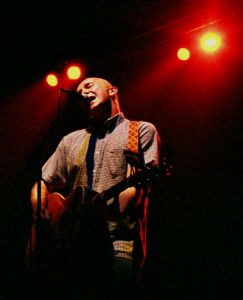
Catching up recently with Simon Reynolds’ excellent Blissblog, a simple little statement, almost hidden away beneath a substantial piece of text, caught my eye, though I wished, immediately, disbelievingly, that it hadn’t. It read, succinctly, ‘RIP Grant McLennan’. After a brief, stunned pause to reflect but not really digest, I Googled for some substance behind this headline, soon finding confirmation of the sad fact that, indeed, this mightily talented man had passed away, suddenly, on 6th May, at a mere 48 years of age. An official tribute & many responses may be found on the Go-Betweens’ website, a fitting selection of warm comments here & a really nice, personal, blog entry here. Personally, given the quality of Grant’s work over the last 25 years, most notably as one half of The Go-Betweens’ songwriting partnership, with Robert Forster (whose contribution mustn’t be overlooked or forgotten at this time), & my abiding & profound love of those songs & that band, such is & will surely remain a particularly keenly-felt loss. Deepest sympathy to those who loved, knew & worked with him.
From first hearing the dreamlike, haunting refrain of ‘Cattle & Cane’, somehow different & inexplicably magical, way back when, on to the melancholy beauty of ‘Bachelor Kisses’ via Robert’s ‘Man o’Sand to Girl o’Sea’, courtesy of the mid-80s Sunday night team on Radio Merseyside (the ’Tweens being, most unusually for those times, not a ‘Peel band’), I was seduced by the wonder & warmth, the intelligence, the quiet, subtle yet intense passion, the essential humanity, of these songs, & all those subsequent gorgeous, timeless, life-affirming tunes, the beautiful bittersweet compositions, the irresistible sing-along favourites, the wit, wisdom, emotion & rare articulacy of the lyrics (“The rain hit the roof with the sound of a finished kiss”, from ‘The Wrong Road’, to quote but one example among numerous poetic gems).
Grant McLennan wrote so many wonderful songs, from ‘Cattle & Cane’ on, in particular those on the 4 albums spanning the period of the Go-Betweens’ most intensely flourishing creativity & true, untouchable greatness – ‘Spring Hill Fair’, ‘Liberty Belle & the Black Diamond Express’, ‘Tallulah’ & ‘16 Lovers’ Lane’ – that serve, & will continue to do so, as a fitting monument to his talents & memory: ‘Bachelor Kisses’, ‘Unkind & Unwise’, ‘The Ghost & the Black Hat’, ‘The Wrong Road’, ‘In the Core of a Flame’, ‘Apology Accepted’, ‘Right Here’, ‘Someone Else’s Wife’, ‘Bye Bye Pride’, ‘Hope Then Strife’, ‘Love Goes On’, ‘Quiet Heart’, ‘The Devil’s Eye’, ‘Streets of Your Town’ - classics all, informed by & infused with a unique sensibility that communicates intimately, personally, yet has a universal quality, such was the man’s great gift, so generously shared. Each & all are songs that, once heard & touched by, remain in the heart & mind, as precious as dear friends & loved ones. Listening to those albums in tribute, & also the 3 more recently released collections from the reborn partnership & band, gratefully welcomed back after their 90s hiatus (how lovely & comforting it was to hear 'Magic in Here' opening 'The Friends of Rachel Worth', for example, or 'Poison in the Walls' from 'Bright Yellow, Bright Orange', like old, dear friends returning & seeming, immediately, to never have been away), the songs remain as wonderful as they ever were, familiar yet, with their subtle, layered depths, ever interesting, fresh & rewarding, & - acknowledging Robert Forster’s equal if different but complementary contribution in each case – I’m not alone in regarding ‘Liberty Belle’ in particular as one of the most perfect of all time. Certainly it’s a great work of art, & is one of my most favourite LPs, of any band, anyway. Aw, shucks, they're all great & it's a damn shame there won't be any more now.
Among the many splendours of ‘Tallulah’, it occurred that no one else has written a song quite like, for instance, ‘Someone Else’s Wife’ (which still features one of the most delightful endings to a song, courtesy of Amanda Brown’s violin, ever) - most other pop music sounds so shallow, so illiterate, lyrically & emotionally, in comparison (although, of course, that's perhaps it's very raison d'etre!) - & few have written anything to surpass the magnificent ‘Bye Bye Pride’, perhaps my particular favourite of Grant’s songs, just pipping ‘The Wrong Road’ (or any number of those previously mentioned) most times, first heard, with alternative lyrics, as part of an Andy Kershaw radio session that preceded the album’s release, loved then & to this day.
It’s sad & a terrible shame to have to write of Grant McLennan’s passing, but I know I’ll dive, frequently, into the welcoming depths of those beautiful songs he gave & left, for the fondest of memories. Thanks, Grant.
Listen yourself to the magic of The Go-Betweens, it’s what your ears are for &, under the sad circumstances that make their special songs all the more precious & their beauty all the more poignant, it’s the very least you can do, in honour. And read David Nichols' excellent biography of the band, erudite & packed with entertaining anecdotes, too, to get to know them & their art better still.
Saturday, May 20, 2006
Red Doors Revisited
A peripatetic working life has of late afforded the opportunity of returning to the location where I previously encountered those most aesthetic pairs of Gary Humesque red gloss doors (see this post) & of thus taking some photos, which, although offering but a very poor substitute to the actual experience of the real thing, illustrate something of the visual attraction of the doors, their physical nature & qualities of the paint surface, etc. The images are hereby presented in a form that is intended to equate in some way to the experience as lived, in time & space, of approaching & traversing the areas around & before the doors, observing the play of light over the gloss surfaces & always being returned to the insistent physical nature & aesthetic, painterly quality of these wonderful things.
























Monday, May 08, 2006
Meyer’s Minimalism

Two months between updates is far too long a gap, but at least part of the hiatus has been spent most profitably, reading James Meyer’s wonderful ‘Minimalism: Art & Polemics in the Sixties’, an exemplary work of art historical scholarship which contextualizes the work & its coming-into-being of Judd, Morris, Flavin, Andre, Truitt & others within the theoretical, critical & philosophical debates of its time, most enlightening & re-inspiring, given the engagement I formerly enjoyed with, particularly, the theoretical issues surrounding such practice: it’s high time to get back on that particular wagon & then processing such thinking in some practical form.
Friday, March 17, 2006
More Double Black Lines (Contextualized)
As might by now be expected, my need to document the existence of the local ‘double black lines’ (see previous posts 1, 2, 3 & 4) shows no sign of abating, & thus is presented a selection of the most recent photographs taken of examples of them, a continuation of which process might now be officially classed as ‘A Project’.
Some of these images, mostly taken at a new location, have particularly prominent & impressive fissures in the underlying road surface, which add an interesting & dramatic element of ‘drawing’ into the compositions in which they occur. Present too are joins, overlaps or gaps where brushstrokes end & begin – which strikes me at the moment as being rather Rymanesque (* see below) - another engaging 'painterly' touch that lends one to viewing the images from an artistic perspective & as suggesting themselves ever more insistently suitable subject matter for transformation into paintings.





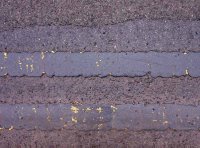















I thought, on the occasion of this post, & especially since I’ve again mentioned an artist & their work in relation to my photographs of the double black lines, that it would be a good idea to include some of the images/artists I have in mind as informing the photographs as being seen & read in the tradition of certain types of painting, & of suggesting themselves as being potential suitable subject matter for a body of painting(s).
In terms of black paintings specifically, here are 4 examples.
The first is of the original of the species, Malevich’s ‘Black Square’ - one of a number of his early 20th century explorations into the monochrome - which is exactly what it says it is. Notice how time has aged this painting, the surface deteriorating into a network of cracks, & how such detail links it physically to the surface textures of the road & some of the black painted lines in my photos.

Next is one of Frank Stella’s ‘Black Paintings’. The light lines here are not the ‘figure’ in the basic composition, drawn upon the surface, but rather the unpainted ground of the canvas upon which the black paint is applied. Again, the traces of yellow, the thin yellow lines, showing through the overpainted black to a greater or lesser degree in the double black lines photos relate to such an image.

Thirdly, one of Ad Reinhardt’s monochrome ‘Abstract Paintings’ ('No. 5' in this case), where the various blacks used in the composition – each tending very subtly towards red, green, blue, etc – are virtually indistinguishable, only revealing themselves & their difference from their neighbours through prolonged viewing. Having seen such paintings, I know how intense & rewarding such an experience can be. Here, the subtle changes in tone & hue relate to the patchwork nature & textures of the road surfaces, & the ‘different’ black of the painted lines upon them. As with the Stella example, simplicity of composition is also intended to relate to the double black lines images.
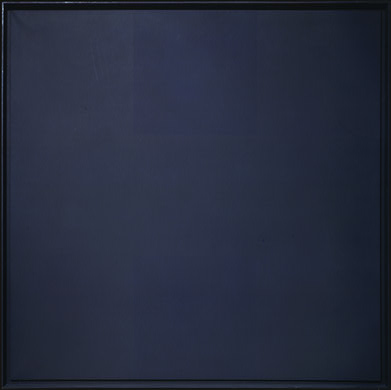
Here's a detail of the above, showing a clearer distinction between the various subtly different black areas.

Finally, a contemporary example of a black monochrome, Gillian Carnegie’s ‘Black Square’ as exhibited at the Turner Prize 2005 show. This painting, which is engaged critically with Malevich’s example, actually features representational image content & thus the illusion of three dimensional space within its heavily & laboriously textured surface (which, through the use of relief in this manner, does in fact have an actual three-dimensional quality), within the genre of the landscape, in the form of a night-time woodland scene of tree boles, leaf-strewn paths, etc. Again, the double black lines photos rendered as paintings would employ such painterly surface textures & feature representational content as faithfully reproduced images of the road surfaces & the painted lines.

This is the painting as seen in an exhibition context,with a different play of light upon its surface.

Moving on, this time into the inverse realm of the white monochrome, & some examples that may, in fact be even more influential upon my thinking & looking in relation to the double black lines images.
Firstly, a couple of variations on Jasper Johns’ ‘White Flag’, which was a development of his original, seminal & preceding ‘Flag’ painting.



As may be observed, especially in the first ‘White Flag’ image, the collage-&-encaustic-(wax)-fixed-pigment technique used here gives such a variety of subtle surface textures, hues & tones, & this, in addition to the ‘given’ subject matter & its linear graphic simplicity, & the areas of ground showing through the painted surface, relates very closely I think – more so even than the black monochromes quoted above - to the possibilities inherent in rendering the double black lines images as paintings with rich potential for painterly exploration.
These are the 'White Flag' images inverted to black, to perhaps illustrate something of this point.
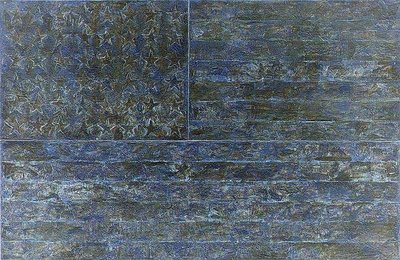

Finally, a couple of *Robert Ryman's white paintings, illustrating but a frustrating, alas, little of the nature of the application of the paint, in regular strokes & lines, the process of which gives the image a grid-like composition. As with Johns, Ryman's technique results in a great variety of subtle textural & tonal effects upon the surface of the painting, many minor variations upon the major theme of 'whiteness', allowing one to appreciate the painterly quality of such, & which is something I would hope to achieve should the double black lines images ever be realised as paintings.
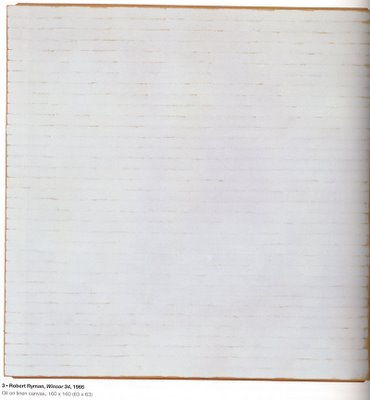
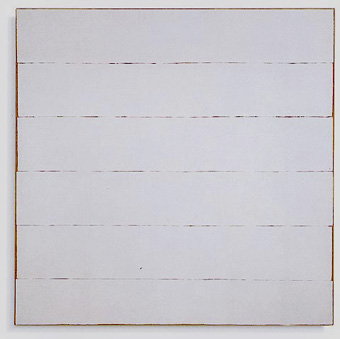
Again, the inverse of the latter Ryman image alludes to the double black lines images &, hopefully, helps to contextualize these images as seen from a painterly perspective & envisaged as existing within the context of continuing a certain tradition of painting.

Some of these images, mostly taken at a new location, have particularly prominent & impressive fissures in the underlying road surface, which add an interesting & dramatic element of ‘drawing’ into the compositions in which they occur. Present too are joins, overlaps or gaps where brushstrokes end & begin – which strikes me at the moment as being rather Rymanesque (* see below) - another engaging 'painterly' touch that lends one to viewing the images from an artistic perspective & as suggesting themselves ever more insistently suitable subject matter for transformation into paintings.





















I thought, on the occasion of this post, & especially since I’ve again mentioned an artist & their work in relation to my photographs of the double black lines, that it would be a good idea to include some of the images/artists I have in mind as informing the photographs as being seen & read in the tradition of certain types of painting, & of suggesting themselves as being potential suitable subject matter for a body of painting(s).
In terms of black paintings specifically, here are 4 examples.
The first is of the original of the species, Malevich’s ‘Black Square’ - one of a number of his early 20th century explorations into the monochrome - which is exactly what it says it is. Notice how time has aged this painting, the surface deteriorating into a network of cracks, & how such detail links it physically to the surface textures of the road & some of the black painted lines in my photos.

Next is one of Frank Stella’s ‘Black Paintings’. The light lines here are not the ‘figure’ in the basic composition, drawn upon the surface, but rather the unpainted ground of the canvas upon which the black paint is applied. Again, the traces of yellow, the thin yellow lines, showing through the overpainted black to a greater or lesser degree in the double black lines photos relate to such an image.

Thirdly, one of Ad Reinhardt’s monochrome ‘Abstract Paintings’ ('No. 5' in this case), where the various blacks used in the composition – each tending very subtly towards red, green, blue, etc – are virtually indistinguishable, only revealing themselves & their difference from their neighbours through prolonged viewing. Having seen such paintings, I know how intense & rewarding such an experience can be. Here, the subtle changes in tone & hue relate to the patchwork nature & textures of the road surfaces, & the ‘different’ black of the painted lines upon them. As with the Stella example, simplicity of composition is also intended to relate to the double black lines images.

Here's a detail of the above, showing a clearer distinction between the various subtly different black areas.

Finally, a contemporary example of a black monochrome, Gillian Carnegie’s ‘Black Square’ as exhibited at the Turner Prize 2005 show. This painting, which is engaged critically with Malevich’s example, actually features representational image content & thus the illusion of three dimensional space within its heavily & laboriously textured surface (which, through the use of relief in this manner, does in fact have an actual three-dimensional quality), within the genre of the landscape, in the form of a night-time woodland scene of tree boles, leaf-strewn paths, etc. Again, the double black lines photos rendered as paintings would employ such painterly surface textures & feature representational content as faithfully reproduced images of the road surfaces & the painted lines.

This is the painting as seen in an exhibition context,with a different play of light upon its surface.

Moving on, this time into the inverse realm of the white monochrome, & some examples that may, in fact be even more influential upon my thinking & looking in relation to the double black lines images.
Firstly, a couple of variations on Jasper Johns’ ‘White Flag’, which was a development of his original, seminal & preceding ‘Flag’ painting.



As may be observed, especially in the first ‘White Flag’ image, the collage-&-encaustic-(wax)-fixed-pigment technique used here gives such a variety of subtle surface textures, hues & tones, & this, in addition to the ‘given’ subject matter & its linear graphic simplicity, & the areas of ground showing through the painted surface, relates very closely I think – more so even than the black monochromes quoted above - to the possibilities inherent in rendering the double black lines images as paintings with rich potential for painterly exploration.
These are the 'White Flag' images inverted to black, to perhaps illustrate something of this point.


Finally, a couple of *Robert Ryman's white paintings, illustrating but a frustrating, alas, little of the nature of the application of the paint, in regular strokes & lines, the process of which gives the image a grid-like composition. As with Johns, Ryman's technique results in a great variety of subtle textural & tonal effects upon the surface of the painting, many minor variations upon the major theme of 'whiteness', allowing one to appreciate the painterly quality of such, & which is something I would hope to achieve should the double black lines images ever be realised as paintings.


Again, the inverse of the latter Ryman image alludes to the double black lines images &, hopefully, helps to contextualize these images as seen from a painterly perspective & envisaged as existing within the context of continuing a certain tradition of painting.

Subscribe to:
Posts (Atom)